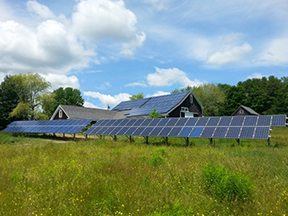 Community Solar (also called Shared Renewables) offers a new option for many homeowners who would like to add solar power to their energy options, but are not able to do so. It’s one of the fastest growing sectors in renewables, and fully 25 states currently have a community solar program online, according to the Solar Energy Industries Association, with another 12 states and the District of Columbia putting policies in place to encourage growth in the medium.
Community Solar (also called Shared Renewables) offers a new option for many homeowners who would like to add solar power to their energy options, but are not able to do so. It’s one of the fastest growing sectors in renewables, and fully 25 states currently have a community solar program online, according to the Solar Energy Industries Association, with another 12 states and the District of Columbia putting policies in place to encourage growth in the medium.
There are three main reasons residential homes may seek out community solar, which are sometimes located on publicly owned or leased land:
- Renters and condominium owners are often prohibited from adding solar panels to their property.
- The roof may be too shaded
- The size or orientation of the roof may not make solar installations a good match for electricity needs
There are several ways in which a home owner can access solar power through these projects:
Utility Sponsored Model— The solar arrays built and owned by a utility, which then offers solar electricity to customers via a long term contract for a set rate, which is usually higher than the current rate. The customer benefits by being able to lock his or her electricity costs over time as standard rates rise.
Solar Farm Utility On-bill Credits — Individuals join together and purchase shares of a large-scale solar farm, each buying a percentage of the solar power produced, much like the way a condominium development is set up. The solar power is credited proportionally to the shareholders’ individual electricity accounts by the utility. The initial investment by the shareholders fund the lease or purchase of the land and the installation of the solar array. Additionally, these community solar shares are eligible for the Federal solar tax credit of 30 percent. This system is presently available in Maine and several community solar programs are now online. One of the benefits of On-bill Credits is that the shares of the solar farm can be transportable as long as the customer remains in the service area, and may be sold or transferred, just like a condominium. Plus, the utility is responsible for the paperwork!
Special Purpose Entity Model— This model is similar to the On-bill Credits option, but in this case individuals form a business partnership to build a solar array to sell the electricity to the utility, with a long-term return on investment.
If solar is appealing, but not feasible as an installation on, or next to, your log home, one of these options may allow you to participate in solar power development remotely.
